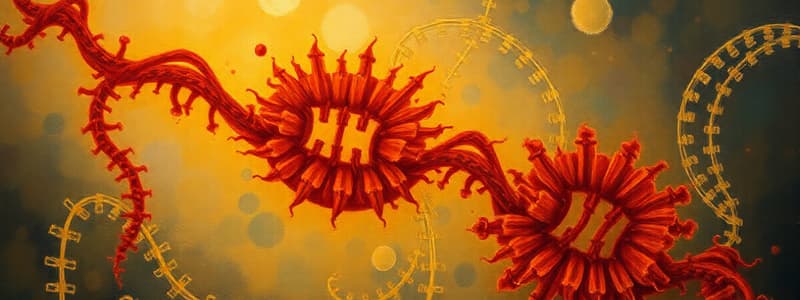Podcast
Questions and Answers
The lac operon consists of three structural genes that code for enzymes that break down glucose.
The lac operon consists of three structural genes that code for enzymes that break down glucose.
False (B)
Regulatory proteins can either stimulate or prevent the binding of RNA polymerase to the promoter.
Regulatory proteins can either stimulate or prevent the binding of RNA polymerase to the promoter.
True (A)
Inducers change the conformation of a repressor, allowing transcription to occur.
Inducers change the conformation of a repressor, allowing transcription to occur.
True (A)
Posttranslational modifications of protein do not affect the expression of genes in a cell.
Posttranslational modifications of protein do not affect the expression of genes in a cell.
All genes in an operon are expressed together and transcribed into a single polycistronic mRNA.
All genes in an operon are expressed together and transcribed into a single polycistronic mRNA.
The lac operon in E. coli is induced when glucose is available.
The lac operon in E. coli is induced when glucose is available.
Attenuation is a mechanism that can regulate transcription after it has started, and it is applicable to eukaryotic systems.
Attenuation is a mechanism that can regulate transcription after it has started, and it is applicable to eukaryotic systems.
Tryptophan acts as a co-repressor in the regulation of the trp operon.
Tryptophan acts as a co-repressor in the regulation of the trp operon.
The binding of lactose to the repressor protein facilitates RNA polymerase's ability to initiate transcription.
The binding of lactose to the repressor protein facilitates RNA polymerase's ability to initiate transcription.
Sigma factors are not involved in the regulation of RNA polymerase binding to promoters.
Sigma factors are not involved in the regulation of RNA polymerase binding to promoters.
Flashcards
Gene Expression Regulation
Gene Expression Regulation
The process of controlling when and how genes are used to make proteins.
Operon
Operon
A group of genes that are transcribed together in prokaryotes.
Lac Operon
Lac Operon
A specific operon in bacteria that controls the breakdown of lactose.
Repressor Protein
Repressor Protein
Signup and view all the flashcards
Inducer
Inducer
Signup and view all the flashcards
Lac Operon Induction
Lac Operon Induction
Signup and view all the flashcards
Co-repressor
Co-repressor
Signup and view all the flashcards
Trp Operon
Trp Operon
Signup and view all the flashcards
Negative Regulation
Negative Regulation
Signup and view all the flashcards
Attenuation
Attenuation
Signup and view all the flashcards
Study Notes
Learning Outcomes
- Students should be able to explain the importance of gene expression regulation.
- Students should be able to explain prokaryotic gene expression regulation using the lac operon as a model.
- Students should be able to describe the role of regulatory proteins and DNA sites (enhancers and response elements).
- Students should be able to describe the clinical significance of dysregulated gene expression.
Importance of Gene Regulation
- Cells adjust gene expression to adapt to changing environments.
- This adaptability is essential for survival.
- Gene regulation allows organisms to respond to stimuli.
Regulation in Prokaryotes: The Lac Operon
- Operons are common in prokaryotes.
- An operon includes: a promoter, operator, and structural genes.
- The lac operon has 3 structural genes that code for enzymes for lactose breakdown .
- The operator controls RNA polymerase access to the promoter.
- Repressors bind to the operator, preventing transcription.
- An inducer (like lactose) can bind to the repressor, preventing it from binding to the operator, allowing transcription.
DNA Regulation
- Regulatory proteins like repressors and inducers bind to specific DNA sites (operators, enhancers, response elements).
- Transcription factors bind to specific DNA sequences to control gene expression.
- This interaction affects the initiation of transcription.
Gene Expression Regulation Mechanisms
- Negative Control: Repressors block transcription initiation.
- Positive Control: Activators (inducers) enhance transcription initiation.
- Co-repressors: A nutrient or its metabolite that binds to repressor → activating (co-repressor) the repressor. -Co-repressor + repressor complex bind to operator → prevent RNA pol → prevent gene transcriptin.
- Induction: An inducer activates the repressor.
- Repression: A co-repressor is needed to activate the repressor.
Regulation Levels in Bacteria
- Transcriptional control: Regulation of RNA polymerase binding to the promoter region.
- Translational control: Regulation of mRNA stability or translation rate.
- Post-transcriptional control: Regulation of protein activity or alteration.
Eukaryotic Gene Regulation
- Eukaryotic gene regulation occurs at multiple stages, from DNA structure to protein processing and degradation.
- Chromatin remodeling, methylation, and gene rearrangement are part of DNA and chromosome level regulations.
- Gene amplification and gene deletions are part of chromosome level regulations.
Regulation of Protein Synthesis in Eukaryotes
- Regulation occurs at multiple levels, including DNA structure, transcription, mRNA processing, translation, and protein modification.
- Specific regulatory proteins, such as transcription factors, can control gene expression.
Transcription Factors Affecting Regulation
- Many transcription factors activate or repress transcription of mRNA by binding to DNA regulatory sequences affecting the initiation of transcription.
Mechanisms of Translation Regulation
- Phosphorylation of translation initiation factors.
- Translational repressors (typically bind to 3’ UTR).
- Disruption of elF4E and elF4G interactions.
- RNA-mediated regulation (gene silencing).
mRNA Processing
- Alternative splicing and polyadenylation sites.
- RNA editing: altering bases in mature mRNA.
- mRNA processing is vital for correct protein production
Gene Silencing by RNA Interference
- Small interfering RNAs (siRNAs) can silence genes by targeting specific mRNA sequences for degradation or translational inhibition.
Example of co-repressor regulation : trp operon
- trp operon encodes enzymes for tryptophan synthesis.
- Tryptophan acts as a co-repressor, binding to and activating the repressor.
- This complex binds to the operator and blocks transcription of the trp operon.
Bacterial Operons
- lac operon: involved in lactose metabolism.
- trp operon: involved in tryptophan synthesis
- Both are examples of operons
Regulation by sigma factors
- Sigma (σ) factors bind to RNA polymerase stimulating binding to certain promoters activating transcription.
- sigma 70: standard sigma factor in E. coli
- sigma 32: helps RNA to recognize promoters of heat-shock proteins.
Attenuation of transcription
- High levels of tryptophan can attenuate (reduce) transcription and expression of the trp operon.
Examples of Human Diseases due to Gene Regulation
- Prader-Willi syndrome.
- Angelman syndrome.
- Androgen insensitivity syndrome (AIS)
Epigenetic Modifications
- DNA Methylation: Methylation of cytosine bases can silence/repress gene expression.
- Histone acetylation: promotes gene expression.
- Histone deacetylation: reduces gene expression.
Diseases due to gene expression dysregulation
- Various cancers involve gene disruption, aberrant expression, amplification, and deletion.
Differences between Prokaryotic and Eukaryotic Gene Regulation
- Prokaryotes typically use operons to regulate multiple genes jointly.
- Eukaryotes tend to regulate genes individually.
Studying That Suits You
Use AI to generate personalized quizzes and flashcards to suit your learning preferences.




